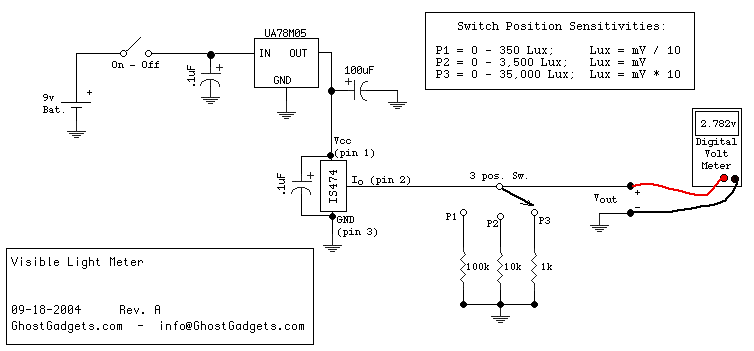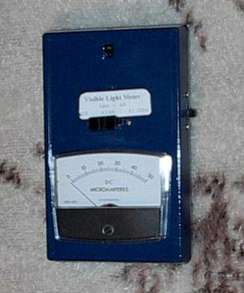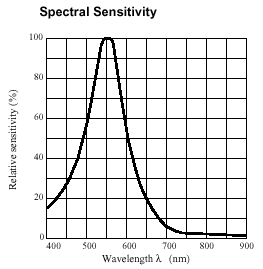|
|
Posted September 2004
Printable Version

Construction Details
This is a simple visible light meter that is very easy to build, as well as inexpensive (around $5 for parts from DigiKey). The IS474 is a visible light sensor that has the very useful feature of passing .1 uA per lux, which can easily be converted to a measurable voltage using standard value resistors. There is a three position switch in this schematic, which allows you to choose the measurement level for better resolution, with a maximum reading of 35,000 lux. Then, the voltage across that resistor is simply measured with a digital volt meter - inexpensive ones are available at Wal-Mart or Radio Shack for under $20. The voltage output is 0 - 3.50 volts, in which the conversion to lux varies depending on which position the sensitivity switch is set on. Also note that this voltage could also be read on an Analog to Digital Converter, but it would be necessary to buffer the output impedance with a voltage follower after the + terminal of Vout. The IS474 can be mounted in many ways - as long the light "window" is exposed to whatever light source you want to measure. The power supply can be from a power transformer, 9 volt battery, or any other 7-25 volt source.
For my meter, I modified the schematic a bit - instead of using a voltmeter to read the output, I used an ammeter (0 - 50 uA) to measure the current from the IS474 directly. For the sensitivity switch, the first position just measures the entire current from the IS474, and for the other two positions I used a current divider relationship to put 1/10th and 1/100th the current through the ammeter. This was a bit tricky to calculate, and the resistor values will depend on the internal resistance of the ammeter, but the extra effort was worth it. Below is a photo of my visible light meter - built into a nice handheld package, with an analog meter face, along with the spectral response of the IS474 (which is very similar to that of the human eye):


<- Back to Main How-To Page
Disclaimer
Disclaimer: The author(s) of these articles, inventors, host(s) and sponsor(s) of this site are not responsible in any way for damages, direct or indirect, resulting from your performing, attempting to perform, or inability to perform, the construction and/or modifications described here. If you follow the instructions on this website carefully, your project should be successful, but we are not responsible for any damages done as the result of building this project!
Though the building/modification instructions are offered free of cost to the public on this website, the author/designer/inventors of this procedure and devices still retain all copyrights on the projects featured here. In other words, just because you built it doesn't mean you invented it! We offer you these projects as a way to improve your own research, and share with the world the knowledge we have been so fortunate to obtain at our research sites. The only thing we ask in return is to give the appropriate inventors credit when asked who came up with the idea.
Text and banner links, and donations are always greatly appreciated and welcomed. By reading these how-to pages, and attempting these projects you automatically agree to this disclaimer. We hope you find good use for this information, and good luck with your projects!
|
|